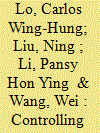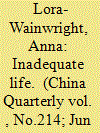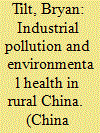|
|
|
Sort Order |
|
|
|
Items / Page
|
|
|
|
|
|
|
| Srl | Item |
| 1 |
ID:
147422


|
|
|
|
|
| Summary/Abstract |
While it is widely accepted that industrialization has brought both environmental pollution and economic growth in rural areas of China, very little is known about whether the negative effects of industrial pollution on rural residents have been proportionally offset by positive effects due to improvements in off-farm income. This paper improves our understanding of these tradeoffs by conducting an empirical analysis based on a set of nationwide panel data collected in 2008 and 2012 and covering five provinces, 101 villages, and 2020 households. Evidence is found to suggest that it is not always the case that rural households that are affected by pollution reap the off-farm employment benefits associated with industrialization. Specifically, although industrial pollution incidence is found to be positively related with the level of local off-farm employment, this relationship is statistically insignificant when migrant labor is included. It can be explained as areas that less economically benefited from industrialization tent to have more labors migrated out and the average annual wage income of one migrant labor is much higher than that of local off-farm labor.
|
|
|
|
|
|
|
|
|
|
|
|
|
|
|
|
| 2 |
ID:
146892


|
|
|
|
|
| Summary/Abstract |
This article traces the institutional development of environmental regulation in urban China, using data from three rounds of surveys of enforcement officials in the Guangzhou Environmental Protection Bureau in 2000, 2006 and 2013. We found that the changes to institutional contexts of regulatory control appear mainly in the fluctuating degree of support from various non-state actors, but not from government entities and regulated industries. While we detected visible organizational changes in local environmental enforcement bureaus, there was also organizational stability. First, the quality of enforcement officials has improved, as reflected by a higher level of education, first from 2000–2006 and then from 2006–2013. Second, the perceived value of enforcement officials in environmental protection was considerably enhanced in the period 2000–2006, and then remained stable from 2006 to 2013. Third, enforcement obstacles in terms of administrative ambiguity remained virtually unchanged from 2000 to 2013, while enforcement power deficit, resource scarcity and procedural ambiguity became more severe. Overall, the general perception of enforcement effectiveness at both the unit and organizational levels has remained the same over the past 13 years, whereas individual-level enforcement was perceived to have become more effective (with significant changes mainly taking place from 2006 to 2013). On the basis of these empirical results, we found that the institutional conditions for stricter enforcement in Guangzhou were visibly improved from 2000 to 2006, but only modestly improved between 2006 and 2013.
|
|
|
|
|
|
|
|
|
|
|
|
|
|
|
|
| 3 |
ID:
121205


|
|
|
|
|
| Publication |
2013.
|
| Summary/Abstract |
Based on fieldwork in a heavily industrialized Yunnan village, this article examines how villagers understand and respond to pollution-related health risks. Building on Robert Weller's (2006) concept of environmental consciousness, it shows that Baocun villagers have developed an acute environmental health consciousness. However, despite earlier instances of collective activism, they no longer act as a community to oppose the harm to their bodies caused by pollution. The article investigates the role of uncertainty surrounding illness causation in deterring action. It argues that uncertainty about pollution's effects on health is reinforced by the social, political and economic contexts and developments in the past few decades. As a result, villagers engage in a form of "lay epidemiology" to make sense of the effects of pollution on their health, but not in a "popular epidemiology" consisting of collective action against presumed health damages. The article concludes with some thoughts on how locals act within and despite uncertainty.
|
|
|
|
|
|
|
|
|
|
|
|
|
|
|
|
| 4 |
ID:
121204


|
|
|
|
|
| Publication |
2013.
|
| Summary/Abstract |
After more than three decades of extremely rapid industrial growth, China faces an environmental public health crisis. In this article, I examine pollution in the rural industrial sector and its implications for community health. Drawing on recent ethnographic research in an industrial township in rural Sichuan, including interviews with government officials, environmental regulators, industrial workers and local residents, I explore how community members understand the linkages between air and water pollution from nearby factories and their health and well-being. The article has two main goals. The first is to examine the various ways in which uncertainty about pollution sources, about the severity of pollution levels and about the links between pollution and human health shapes villagers' experiences of pollution on a day-to-day basis. The second goal is to examine the rising trend of "individualization" taking place in China today and explore how this process is related to people's experiences of toxic exposure. I consider the implications of this trend for how social scientists should approach the study of environmental illness in contemporary China.
|
|
|
|
|
|
|
|
|
|
|
|
|
|
|
|
| 5 |
ID:
147621


|
|
|
|
|
| Summary/Abstract |
Due to the lack of effective institutional constraints, the negative externality from industrial production will lead to environmental pollution and spatial spillover on neighboring units. Because the self-purification capacity of the environmental system is limited, a strong time effect is witnessed. Time lag and spatial spillover need to be considered to mitigate the effect of industrial pollution. Using geographically weighted regression (GWR) and geographically and temporally weighted regression (GTWR), this paper decomposes the spatiotemporal heterogeneity of industrial pollution in China. Results show a significant spatio-temporality in the evolution of the provincial-level industrial pollution since 2007. As the major participants, state-owned enterprises play a leading role in the state economy and greatly affect pollutant emissions. In the central and eastern regions, an increasing proportion of state-owned output values is related to the decrease of industrial pollution emissions, whereas western regions witness an opposite trend. Emissions charge plays a positive role in curbing the emission from industrial enterprises in the central and western regions. A better understanding of the spatiotemporal heterogeneity of industrial pollution is the prerequisite in the alleviation of industrial pollutions to achieve a sustainable economic growth.
|
|
|
|
|
|
|
|
|
|
|
|
|
|
|
|
|
|
|
|
|